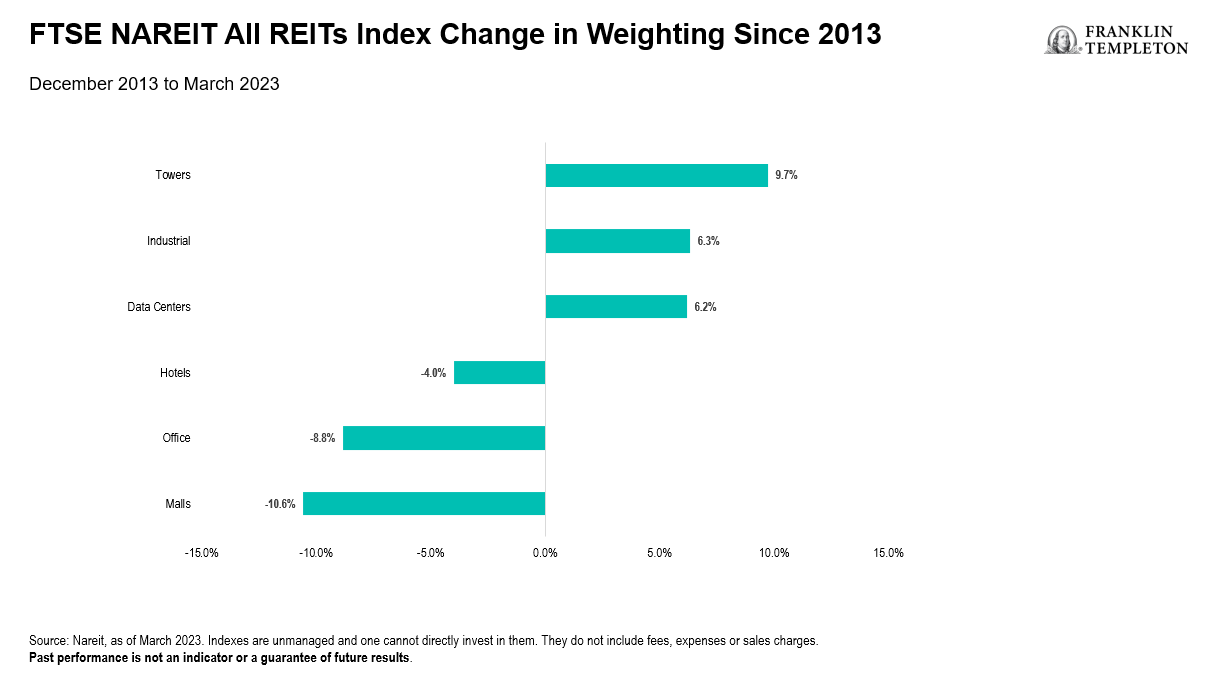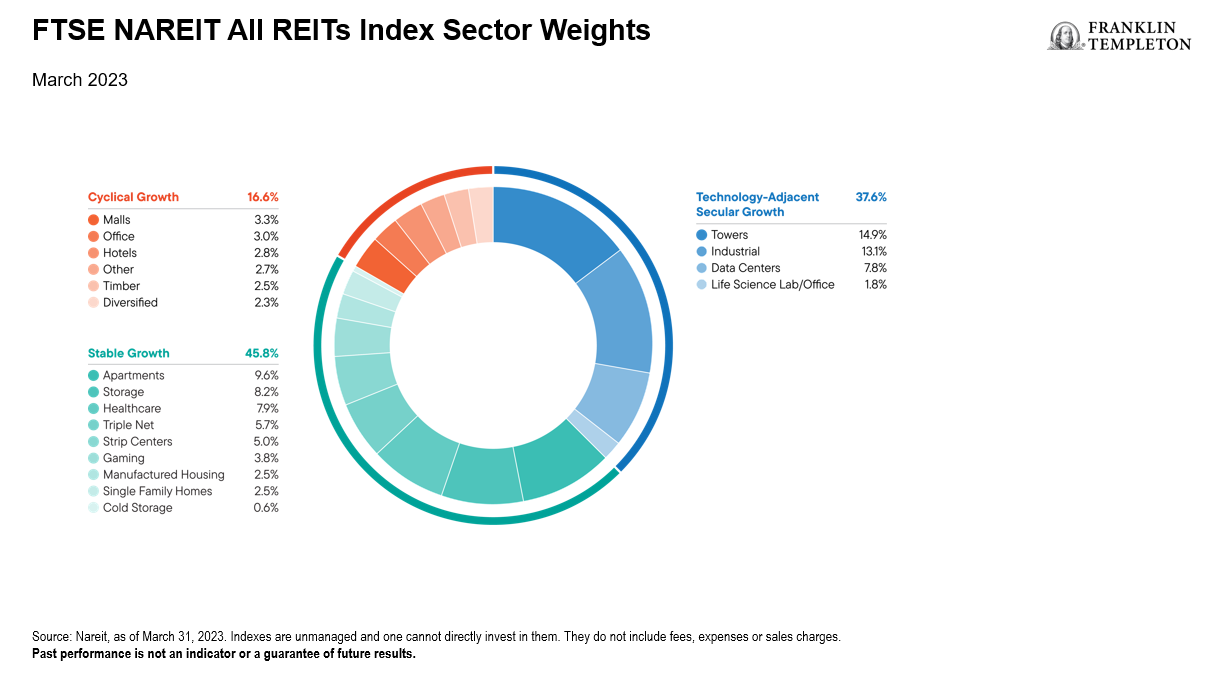Digital disruption has come for real estate!
That’s the headline, right? First, e-commerce emptied brick-and-mortar retail stores and malls, and now, offices have been laid bare by technology tools that make work-from-home a durable reality. If you only read the headlines, you might expect this spells doom for commercial real estate in general, and for real estate investment trusts (REITs) in particular.
At its core, the value of real estate lies in the land, not the structure. That’s what the colloquialism “location, location, location” means. And the best, highest-value use of land is always changing. I [Blair] learned this lesson first-hand as the child of a real estate investor/developer. My father preferred the backwaters of real estate—marinas and mobile home parks—rather than shiny office buildings. But it was his discovery of a specific up-and-coming backwater in the late-1980s that turned odd parcels of unloved but well-located land into gold that built his career. What was it? Self-storage, which has since emerged from the backwaters to be one of the most important subsectors within the US REIT universe.
It shouldn’t be surprising to learn that the composition of the investable REIT universe has continually evolved to favor the disruptors over the disrupted. Indeed, the REIT landscape has seen significant changes over the past decade, reflecting shifts in the real estate market and investor preferences. While it’s true that malls and office space used to be pinnacle of commercial real estate as measured by value, that’s no longer the case. The base building block of commercial real estate is land. How the economy has deployed inherently scarce land has evolved over time, and equity markets have adjusted in tandem to reflect this evolution.
In recent years, specialized technology-adjacent property types such as towers, data centers and industrial have gained prominence in the real estate market due to changes in consumer behavior, technological advancements, and their critical role in supporting the modern economy. Cell towers, for instance, have become crucial in supporting wireless communication infrastructure with the proliferation of smartphones and wireless devices. Data centers have seen significant demand growth as the reliance on cloud computing and data storage continues to increase. Meanwhile, the industrial subsector has seen a surge in demand amid the rise of e-commerce, because fulfillment of online orders requires roughly three times the logistics footprint of traditional brick and mortar. Simultaneously, the value ascribed to disrupted property sectors like malls and office has eroded considerably, reflecting the new realities of the economy.
To provide some quantification of these changes, in December 2013, malls and office comprised more than a quarter of the market capitalization-weighted FTSE NAREIT All REITs Index.1 By contrast, technology-adjacent subsectors (towers, data centers and industrial) comprised, in aggregate, just 14% of the index.2 Times have changed, but the relative importance of these subsectors has changed within the index, too.
As shown in Exhibit 1, the index’s weighting to towers increased nearly 10% in the roughly 10 years through March 2023, while the weightings to industrial and data centers have each grown more than 6%. In contrast, the importance of malls (as measured by benchmark weighting) has fallen more than 10%, traditional office has declined nearly 9%, and even hotels has fallen by 4%.
Exhibit 1: Change in Key REIT Sectors, FTSE NAREIT All REITs Index, December 2013 to March 2023
Consequently, the REIT universe looks much different today, appropriately reflecting the changes that are happening all around us (Exhibit 2). Malls and traditional office REITs combined have fallen to only 6%, with office in particular comprising only 3%.3 Meanwhile, the technology-adjacent subsectors mentioned above now comprise over 35% of the index. Additionally, an array of other new and emerging growth areas has emerged within REITs, including gaming, manufactured housing, single family homes, self-storage, health care and cold storage. Several of the other more mature subsectors such as multifamily, neighborhood centers and single-tenant triple net lease4 each possess stable demand drivers of their own.
Exhibit 2: FTSE NAREIT All REITs Index, March 31, 2023
REITs are not just constrained to malls and offices; quite the contrary, the REIT sector is a dynamic one, with exposure to both secular growth dynamics and sources of bulwark stability. We believe active management of portfolios can further augment each of these investable aspects.
Digital disruption has come for real estate, indeed. But the investable universe already reflects these changes. In our view, an investment in REITs today is much more an allocation into the physical assets that empower the business models of the disruptors than it is a claim of value on the assets that are being disrupted. For this reason, we see tremendous opportunity in the asset class.
WHAT ARE THE RISKS?
All investments involve risks, including the possible loss of principal. The value of investments can go down as well as up, and investors may not get back the full amount invested. Stocks historically have outperformed other asset classes over the long term but tend to fluctuate more dramatically over the short term. Bond prices generally move in the opposite direction of interest rates. Thus, as the prices of bonds adjust to a rise in interest rates, the share price may decline.
The risks associated with a real estate strategy include, but are not limited to various risks inherent in the ownership of real estate property, such as fluctuations in lease occupancy rates and operating expenses, variations in rental schedules, which in turn may be adversely affected by general and local economic conditions, the supply and demand for real estate properties, zoning laws, rent control laws, real property taxes, the availability and costs of financing, environmental laws, and uninsured losses (generally from catastrophic events such as earthquakes, floods and wars).
Investments in alternative investment strategies are complex and speculative investments, entail significant risk and should not be considered a complete investment program. Depending on the product invested in, an investment in alternative investments may provide for only limited liquidity and is suitable only for persons who can afford to lose the entire amount of their investment.
Additionally, investments in private securities and obligations may be thinly traded, have no ready market or exchange and require private negotiation, and which may be restricted as to their transferability. These factors may limit the ability to sell such securities at their fair market value.
IMPORTANT LEGAL INFORMATION
This material is intended to be of general interest only and should not be construed as individual investment advice or a recommendation or solicitation to buy, sell or hold any security or to adopt any investment strategy. It does not constitute legal or tax advice. This material may not be reproduced, distributed or published without prior written permission from Franklin Templeton.
The views expressed are those of the investment manager and the comments, opinions and analyses are rendered as at publication date and may change without notice. The underlying assumptions and these views are subject to change based on market and other conditions and may differ from other portfolio managers or of the firm as a whole. The information provided in this material is not intended as a complete analysis of every material fact regarding any country, region or market. There is no assurance that any prediction, projection or forecast on the economy, stock market, bond market or the economic trends of the markets will be realized. The value of investments and the income from them can go down as well as up and you may not get back the full amount that you invested. Past performance is not necessarily indicative nor a guarantee of future performance. All investments involve risks, including possible loss of principal.
Any research and analysis contained in this material has been procured by Franklin Templeton for its own purposes and may be acted upon in that connection and, as such, is provided to you incidentally. Data from third party sources may have been used in the preparation of this material and Franklin Templeton (“FT”) has not independently verified, validated or audited such data. Although information has been obtained from sources that Franklin Templeton believes to be reliable, no guarantee can be given as to its accuracy and such information may be incomplete or condensed and may be subject to change at any time without notice. The mention of any individual securities should neither constitute nor be construed as a recommendation to purchase, hold or sell any securities, and the information provided regarding such individual securities (if any) is not a sufficient basis upon which to make an investment decision. FT accepts no liability whatsoever for any loss arising from use of this information and reliance upon the comments, opinions and analyses in the material is at the sole discretion of the user.
Products, services and information may not be available in all jurisdictions and are offered outside the U.S. by other FT affiliates and/or their distributors as local laws and regulation permits. Please consult your own financial professional or Franklin Templeton institutional contact for further information on availability of products and services in your jurisdiction.
CFA® and Chartered Financial Analyst® are trademarks owned by CFA Institute.
__________________
1. Source: Nareit, as of March 31, 2023. Data has been adjusted to exclude mortgage REITS. Franklin Templeton has adjusted subsector classifications to improve clarity.
2. Ibid.
3. Ibid.
4. Single-tenant/freestanding assets leased on a long-term basis; the tenant pays the full expenses of the property.



